Report
OPEN GATE An ever-changing exhibition
by Hashimoto Azusa
2015.09.15

From the 15th to the 22nd of June 2015, I stayed in George Town on the Malaysian island of Penang and attended the final week of OPEN GATE – An ever-changing exhibition. Ensembles Asia, sponsored by the Japan Foundation Asia Center, began in April 2014. With a focus on music, it is a project to further networking and exchange with South-East Asia, a target area for the Asia Center, as the main field. The musician Otomo Yoshihide became the artistic director to supervise the entire project, with the 3 projects of the Asian Music Network, Ensembles Asia Orchestra and Asian Sounds Research progressing in parallel.
In the former two cases, it could be said that it is possible to find a certain kind of symmetry. The Asian Music Network, directed by dj sniff (Mizuta Takuro) and Yuen Chee Wai who are based in Hong Kong and Singapore respectively, aim to create a network of professional musicians (though this categorization is not easy to define) who aren’t trapped by traditional values or commercialism. Meanwhile, the Ensembles Asia Orchestra directed by Arima Keiko is a project to create orchestras in various regions that are open for anybody to participate in, based on conversations and surveys in the locales.
To frankly note my impressions of both, including my expectations for them, Network is to lead music to new heights beyond our imagination, through unprecedented collaborations between professionals. The aim of Orchestra on the other hand, which collaborates with amateurs, is to firstly get a clear picture of how the people in the visited regions go about their lives and then to dive deeply inside this to uncover new musical possibilities. Both are sure to use their own methods to lead to an outcome of expanding upon the existing conceptions of music in a certain way.
In this manner, Asian Sounds Research is a project that aims to pursue the edges of ‘music’ and ’sound’ from the starting point, rather than as an end result. The director, the musician Sachiko M, is currently known for diverse activities such as presenting sound installations, photographic works as well as writing pop songs, whereas to begin with she pioneered unexplored territories in electronic music using sine-waves since the 90s, as an avant-garde improvisational musician active throughout the world. With such a background, the direction given to this project is obvious. Through this, Research will focus on works that are difficult to define using pre-existing musical concepts, leading to the exploration of new expressions in all areas that will broaden the meaning of music and sound.The future direction is still unknown, yet as the presence of Tadashi Yonago as the first “basic artist” to be selected suggests, the possibilities of work that uses sounds that lie between music and art was pursued. This is not to aim towards new definitions or categorizations, but with the intent of making the audience actively think about sounds while being dynamically guided by the practice of each artist.
In advance of OPEN GATE, two researches were undertaken in Penang. Regarding the location of Penang and the selection of the basic artists, she first trusted her own instinctive judgment and chose an approach that befitted an improvisational musician by spontaneously putting together the project and team. To analyze this in retrospect, in particular with regards to the selection of a location and basic artists that were not oversaturated by existing fields of music and contemporary art, one can gather that there was an aim to not allow the formation of prejudices in the audience.
Tadashi Yonago participated in a live performance of Network in February this year with trombone and self-made sound objects, so his presence from the first research means that he could be called a ‘hyper-basic artist’. There was always a variety of objects that made sounds placed around the venue for OPEN GATE, and it could be seen that they were modified or moved each day. The sound and silence they produced, as well as the movements and appearance of Yanago himself, was like a continuous bass line that was delicately adjusted each day at the venue, while also being a clear sample that traversed music and art. The parts of the work were mostly procured locally, while the moving elements were hand-made each day by Yonago at the venue. At the talk session on the final day, Yonago said that he intentionally took charge of the sound.
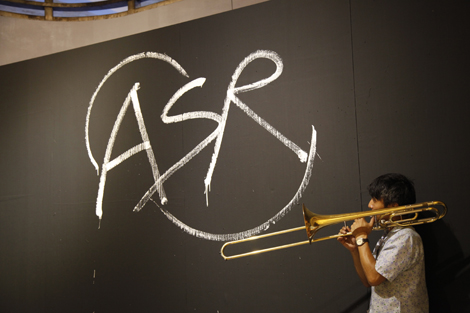
Tadashi Yonago / Photo: Mieko Matsumoto
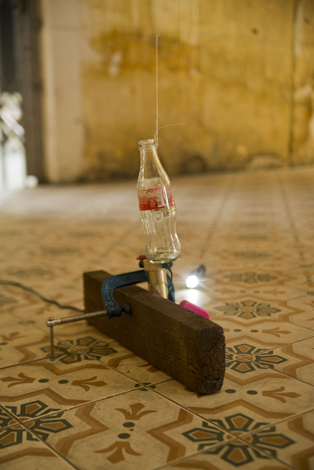
Tadashi Yonago / Photo: Win Win
Like Yonago, Yoshihito Mizuuchi is also based in Osaka and presents his works at galleries while also being active as a musician. The works of Mizuuchi include a sculpture of a giant garbage bag with an illustration drawn on it, an installation where household items move via the growth of onions, and ’sunburn tattoos’ where the Chinese characters for the words sound and gate are imprinted onto his own body through getting sunburnt. There is a stronger impression made by the visual elements in his work compared to Yonago (the humor of these give a feeling of familiarity), yet what Mizuuchi was working with here was the theme of time, which is a prerequisite condition for both sound and music. The garbage bag sculpture made a large noise and moved once every hour with the water being resupplied, which was like an announcement of the time in the venue, while the onion and tattoo were devices that signified time in the future and past respectively.
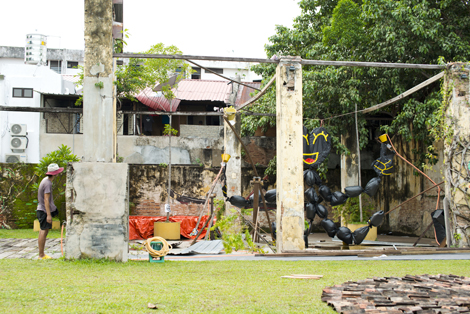
Mizuuchi Yoshihito / Photo: Win Win
The basic artist from Malaysia Annabelle Ng has experience specializing in classical music, but now exhibits artworks. Her work was graphic notation hung from the ceiling (not completed during the exhibition), a small space made in collaboration with Tadashi Yonago to listen to sounds that surround a table that was inlaid with a rotating circular drawings, and an installation where thrown away roof tiles were lined up in a circle in the venue. Sachiko M, who placed more emphasis on the possibilities for future developments rather than the completeness of the work, said the character of the artist was more important than the works when selecting the artists. In this sense, I believe Ng had a mysterious appearance and a distinctive presence. Seeing the unfinished works, she might have had more room to develop the exhibition space and methods. She may use words sparingly, but if she carefully analyzes the purpose of her work, she may have had the potential to commit further to other artists and exhibition spaces.
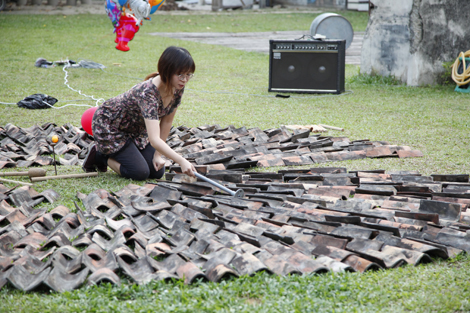
Anabelle Ng / Photo: Mieko Matsumoto
The work of Hoo Fan Chon, another local artist, is formed at the furthest point from sound compared to the rest of the four artists. Hoo hones in on the process through which translations and changes occur when a culture is propagated, focusing on the traces and distortions that are created. His work was a mobile stall where daily items from Bangladesh could actually be purchased. This came from the fact that the venue, the Hin Bus Depot, was inside the Bangladeshi community. Their community mostly consists of immigrants who have come to be laborers on building sites and is relatively new, coming together in the last 10 or so years. It could be seen as an outside culture that has come to George Town, where different ethnicities already coexisted (Bengali immigrants were there from before, but this community near the venue is new). Hoo said the work that he presented was silent, but this stall that raises questions about the relations between the venue and this community is suggestive of the presence of the immigrants who operate as a certain kind of ‘noise’ within the preexisting community, and also forces a commitment to it. In addition, the fact that he sold the zines of fellow Malaysian artist HASA at the stall unexpectedly brought about the element of sound. The handmade booklets that taught Bengali featured the pronunciation in Roman alphabet, so if you speak the sounds then anybody could speak Bengali. It could be said that these zines operated as scores for a performance within the venue, which was pointed out by the curator Yap Sau Bin, who came from Kuala Lumpur on the final day.

Hoo Fan Chon / Photo: Win Win
Until now we have looked at the practices of the basic artists individually, but what made me stop to think in the venue numerous times was just how the collaboration between the artists took place, beyond ‘cooperation’ in the material sense and in a situation where the works kept changing during the exhibition. Furthermore, this question made me strongly aware of the fundamentals of exhibition planning and operation, namely how well the works came together in the venue, and how they approached the audience as an exhibition. To confirm once again, the exhibition is named OPEN GATE – an ever-changing exhibition. Here it would be reasonable to think of the opposing idea to the concept of OPEN that was focused on by Sachiko M is not CLOSED but FIXED. At this exhibition, where it was attempted to avoid various ideas of fixedness, Sachiko M avoided fixing the works or the location, so the artists kept moving the work during the show and never stayed still. When it came time to get rid of the imbalance that inevitably arose, I hope it is acceptable to say that I think the way Sachiko M brought the exhibition together was very much like a band. For example, rather than adjusting the exhibited works concretely and in detail, she explained the overall direction to each artist to try and get a sense of direction from each of them. This method was like completing an improvisational ensemble based on a single score. There were those who quickly responded to the bandmaster’s instructions, while others let time pass as they gradually responded. In this respect the artists were rather scattered.
Taking this into consideration, the 30 to 60 minutes of live collaboration between the artists that I witnessed was of a high level and very stable.
On the first of the two days when Otomo Yoshihide performed live to close the exhibition, Blue Kite, one of his signature songs, reverberated through the venue via his high volume guitar. Interspersed were brittle sounds made by Sachiko M rolling marbles among Ng’s tile work from time to time, and Mizuuchi collaborating with noise from water and a tin plate while moving his sculpture. On the second day, as befits the closing of an exhibition, Sachiko M drew up a simple score that could be understood by anyone and made all the artists participate in the performance. Otomo, who was playing guitar while sitting down at first, then unplugged it and walked around the venue. It was as if he was trying to soak the sound into every corner of the Hin Bus Depot. The performance that started by being centered on Otomo’s guitar gradually came to invite the other artist’s performances, so the balance of the event gently shifted. Yonago produced a variety of sounds by moving the objects, while at the same time letting his trombone loosely resonate as he walked around. Mizuuchi moved his sculpture with water on this day as well, while through the cardboard self-propelled model of the venue (truly an ever-changing, ever-moving exhibition) that he made spontaneously during the end of the exhibition, he mixed together sound and movement. Ng sat in the middle of the tile work, looking like a shaman while touching the roof tiles with drumsticks. Hoo spread chewing tobacco from Bangladesh around the place, with the exotic aroma mixing with the sounds. While Sachiko M quickly gave instructions to the artists for the timing of the performance, she used sine waves to give the relaxed atmosphere of the space a small sense of tension. To finish, she quietly erased the words on the blackboard that also served as the visitors’ list. As befits the closing of an exhibition, the score indicated that all sound, light and movement was to be erased at the end.
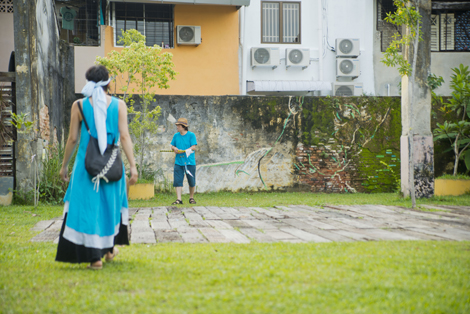
Closing Event / Photo: Win Win
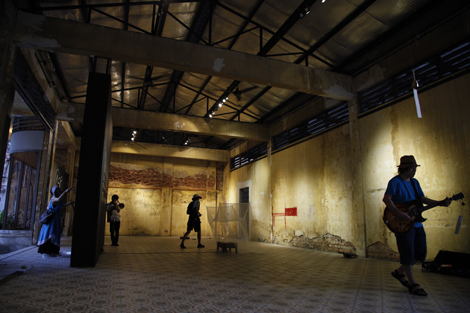
Closing Event / Photo: Mieko Matsumoto
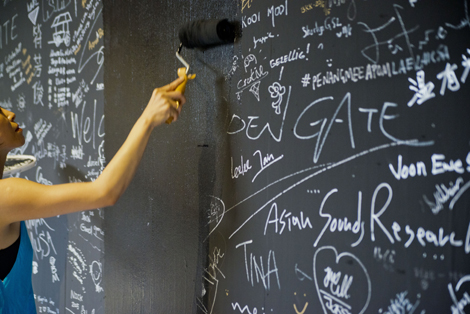
Closing Event / Photo: Win Win
It was an exhibition that had sound as its theme, yet it cannot be denied that the venue was a sonic environment that could occasionally drown out the sound produced by the works. While the hustle and bustle of South East Asia was taken into account, with the traffic on the main streets and the construction noise that was unrelated to the exhibition being heard all the time, the thought could not be helped that it ought to be a little more quieter while trying to concentrate our ears on the delicate sounds of the works. While the good air circulation of the venue was apt for the name OPEN GATE, the unaccustomed heat, humidity and noise was physically tiring like a blow to the body.
Amongst all of this, the wind chimes brought in by the participating artist Otomo towards the end delivered familiar, nostalgic sound and a serene comfort to my ears. Sachiko M stayed consistent with her curatorial policy of not intervening in the exhibition, which was understood by the artists as they placed their work in their own spaces, while Otomo who arrived in the latter stages found a place in the center of the space as well as on a wall that the other artists were not using for his wind chimes.
How did the people of George Town react to the sound of the wind chimes that I found to be nostalgic, as well as the sound and movements produced by the other works? The old streets filled with history became a world heritage in 2008, which could signal a great change in the situation of the city. The hygiene of the city is improving, while the developers’ anticipation for further improvements are raising the land value and thus forcing many citizens to move outside of George Town. The mural that was originally on the walls was by the Lithuanian artist Ernest Zakharevich, who made a significant breakthrough thanks to the 2012 George Town Festival. Tours around the murals have become a fixture of tourism in George Town, with murals that were originally meant to be erased becoming unexpected resources for tourism. It is necessary to pay careful attention to this kind of extensive force that operates beneath the veil of art (of which natural factors are largely included). Many of the people who came to the show were tourists there to see these murals, so how did the work of these Japanese artists come across to them? What did George Town gain from this deeply embedded Research and the openness that the exhibition aspired to? I hope to hear the thoughts of not just the artists and others who participated in the event, but also of the people from Bangladesh who lived near the venue and provided us with delicious curry every day.
Hashimoto Azusa / Curator. Having points of view from both art and music side, Hashimoto is a key figure in Osaka art scene. Participating OPEN GATE as a writer, she is going to appear in Writer’s Talk Session on 21st June, and will follow up the conclusion of OPEN GATE, as a final writer. Curator of National Museum of International Art, Osaka.
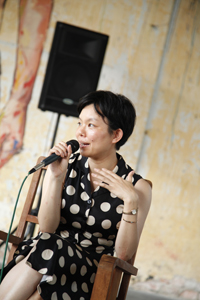
OPEN GATE An ever-changing exhibition
June 2015, Hin Bus Depot,
Photo: Matsumoto Mieko
(Publication: 25 September 2015)
▶Report by Hatanaka Minoru – OPEN GATE An ever-changing exhibitionOPEN GATE An ever-changing exhibition 6~21 June @ Hin Bus Depot
31A, Jalan Gurdwara, Georgetown, 10300 Penang, Malaysia
Asian Sounds Research “OPEN GATE” All Sounds and All Days Digest movie [YouTube]
OPENING EVENT
6 June OPENING EVENT 1 [First Sounds] featuring guest: Tenniscoats
7 June TALK SESSION 1 [Panel discussion with Gabija Grusaite] guest: Minoru Hatanaka
7 June OPENING EVENT 2 [First Sounds +] Tenniscoats with all artists
SECOND WEEK EVENT
13 June SECOND WEEK EVENT 1 [Second Sounds] featuring guest: chi too
14 June TALK SESSION 2 [Panel discussion with Gabija Grusaite] guest: Ong Jo-Lene
14 June SECOND WEEK EVENT 2 [Second Sounds ++] chi too with all artists
SILENT MOVIE NIGHT
16 June [silent movie with silent sounds] featuring guest: Kok Siew-wai/ with Tadashi Yonago, Sachiko M
CLOSING EVENT
20 June CLOSING EVENT 1 [Final Sounds] featuring guest: Otomo Yoshihide
21 June TALK SESSION 3 [Panel discussion with Gabija Grusaite ] guest: Azusa Hashimoto
21 June CLOSING EVENT 2 [Final Sounds +++] All artists and everyone / [FILM SHOW by Ee Yan]
—
Asian Sounds Research WEB SITE:http://www.soundsresearch.com
